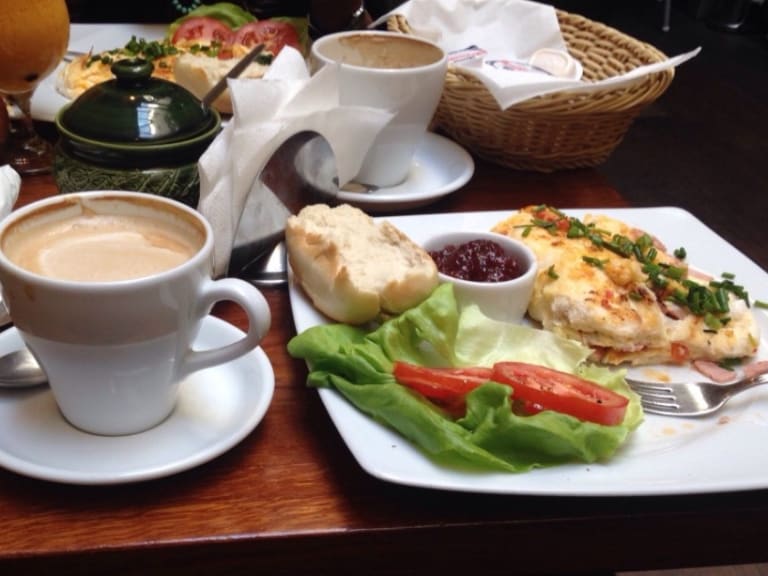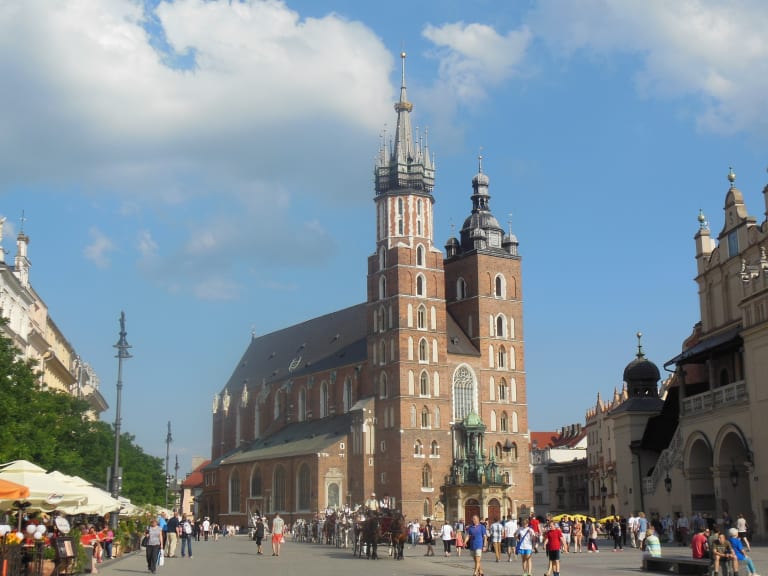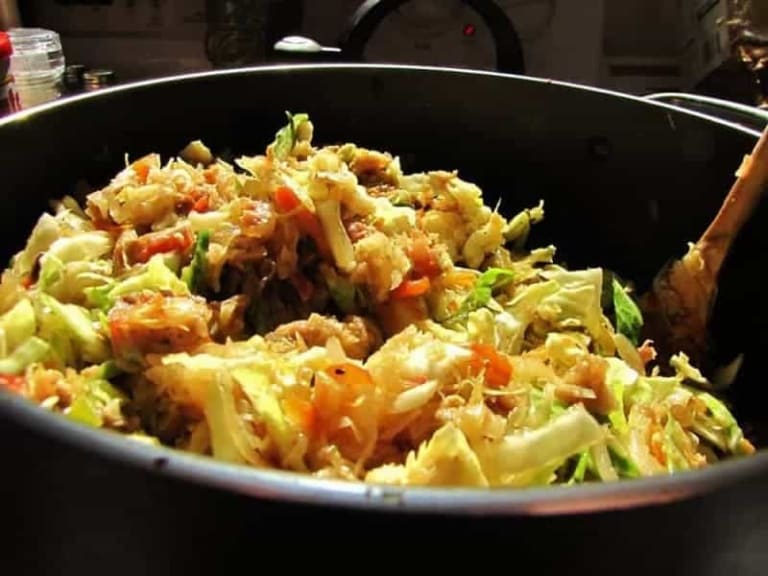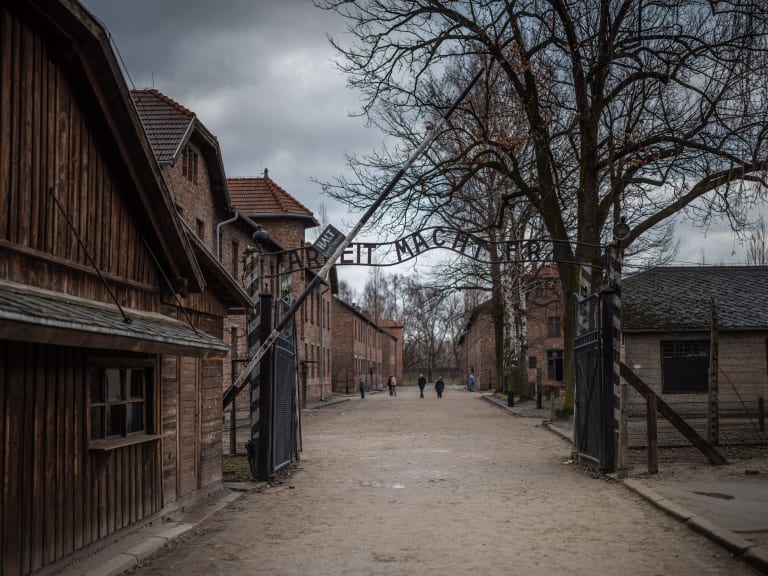More about: Things to Do in Krakow in 3 Days
History, architecture, gastronomy, culture? In three days in Krakow you will have time to enjoy all this and, in addition, make one of the most popular (and also toughest) excursions that are made from the Polish city: the visit to the Auschwitz concentration camp.
Day 1: Discover the Old Town

Krakow is a charming city and most of its attractions are located in the Old Town. On your first day, you can spend your time exploring the Stare Miasto district, a medieval gem that you can easily explore on foot.
Start the day with a spectacular breakfast
Before touring Krakow, you need to recharge your batteries. To start the day with energy, I recommend:
- Café Botanica: This bar is located at 9 Bracka Street and specializes in the first meal of the day. Another strong point is the atmosphere of the place: inside, the red brick walls and plants contribute to create a very relaxing atmosphere.
- Wesola Cafe (17 Rakowicka Street), a place run by enthusiasts of the precious dark liquid. Their espressos are made with twice as much ground coffee. Not bad, right?
- Milkbar Tomasza (24 Sw. Tomasza St.).
- Camelot (17 Sw. Tomasza St.).
Explore the Market Square
The Market Square (Rynek Glówny) is the heart of Krakow and an enclave that you will get to know in detail if you book the guided tour of the Old Town. This huge space is dominated by the majestic Cloth Exchange (Sukiennice), a Renaissance-style building that housed the merchants who traded in textiles. Strolling under its arches you can buy a few souvenirs at very competitive prices.
At this point, you can not miss a guided tour of the subway museum Rynek which is four meters below the square and is the youngest museum in Krakow. Its touch screens and holograms take us back to the past, when the square had not even been laid out. Virtual reality is flanked by traditional archaeological finds and the remains of an 11th century cemetery. Due to its popularity and limited capacity, it is preferable to book a guided tour of the Rynek subway museum in advance.
For more information about this first stage, I advise you to read the post what to see and do in Krakow's market square
Enter the nearby St. Mary's Basilica

Next, I recommend that you book a guided tour of Krakow. On most of them you will have the opportunity to admire the Basilica of St. Mary, which has two towers of different heights. Legend has it that under the reign of Duke Boleslaw the Modest it was decided to add two towers to the body of the church and two brothers were given the task. When the younger one realized that his watchtower was lower, he killed his brother out of envy. However, remorse tormented him and on the day the church was to be consecrated, he committed suicide with the same knife.
Once inside, you can appreciate the main attractions of the Basilica of St. Mary, which are essentially three: the blue ceiling, the splendid stained glass windows and the wooden altarpiece by the German artist Veit Stoss depicting the Virgin Mary among the apostles. Generally, you can enter without paying but you will have to use a side entrance. If you are interested in religious tourism, you can check out the article 10 must-see churches in Krakow.
Climb the Wawel Hill
Once you have finished your visit to the basilica, you can take a short walk in a southerly direction. In just over ten minutes you will reach the foot of a limestone rock that rises above the Vistula. At its summit stand two symbols of the city: the castle and the cathedral.
In the 16th century, King Sigismund I the Old called to his court the best Polish and foreign artists who gradually carved this magnificent Renaissance castle that we can appreciate today. I recommend that to delve into this architectural jewel, book a guided tour of the Wawel Castle, which hosts some very interesting permanent exhibitions:
- The royal apartments, a collection of tapestries, portraits of kings and princesses, furniture, and paintings by Italian and Dutch artists.
- The royal apartments
- The treasury and armory of the Crown, which gathers insignia, jewelry, weapons and armor.
- The oriental art exhibition with Turkish and Persian banners, weapons and carpets and a few ceramic objects from China and Japan.
A few meters further on rises the Wawel Cathedral, the ancient coronation place of the Polish kings. After crossing the threshold, you can admire the mausoleum of St. Stanislaus, the patron saint of Poland who was killed by King Boleslaus himself. Thanks to this burial, the Wawel Cathedral is the most important place of worship in the whole country. For more info, you can check the post Visit Krakow Castle: opening hours, how to get there, guided tours and more
Return to your hotel and get ready for dinner

After a first foray, it's time to return to your accommodation for some well-deserved rest. If you want to arrive comfortably and move throughout your stay in Krakow, be sure to buy Krakow Card with pass for museums and transportation
Once at the hotel and after a short rest, you will be ready to go out for dinner. One of the most appreciated restaurants in Krakow is Trzy Gęsi where you can try traditional recipes with a modern twist.
My recommendation is to choose a tasting menu to start a culinary journey in the hands of their experienced chefs. The establishment is located at 7 Kupa Street and is open from 17:00 to 23:00 (Tuesday - Saturday) and from 13:00 to 20:00 (Sunday). Reservations are recommended well in advance.
Conclude the first day in a bar with live music.
Do you love jazz? If the answer is "yes", you absolutely must visit the Piano Rouge. Located in the heart of the city (46 Rynek Glowny Street), this jazz bar is characterized by a burlesque atmosphere with red lights, feather boas and velvet cushions. Live music is played every night from 9 p.m. and while enjoying the show, you can have a cocktail or a glass of wine.
If you're in the mood for something more lively, head to Kazimierz. The Jewish quarter is the most festive area of the city and in Estery Street you will find a bar that has become a real institution: the Alchemia. It owes its name to the alchemists' tools used as decoration and is famous for its musical offerings. In its lounge you can listen to jazz and rock music by well-known local artists and bands.
And if, on the other hand, you are looking for something more popular , book tickets for a folk show in Krakow to enjoy a show starring a folk group in a typical venue.
Day 2: Take a spooky tour

Thousands of tourists travel to Krakow to visit a place that everyone knows and that leaves no one indifferent: Auschwitz. Everyone should cross its entrance at least once in life to not forget this sad page of history.
Spend half a day at the Auschwitz-Birkenau concentration camp
A weekend in Krakow will give you the opportunity to visit an emblematic place of contemporary history: the Auschwitz-Birkenau concentration camp, a symbol of terror and genocide perpetrated against Jews, gypsies and homosexuals. It is not an easy excursion, but sometimes you have to make an effort to see first-hand the horrors of war.
The concentration camp is located in Oświęcim, a town 60 km from Krakow. To get there, you can opt for bus, train or car. However, to understand the historical significance of the place and learn the stories of its prisoners, it is preferable to book an excursion, especially if you travel to Poland during the high season (April to October). Here are some options:
- Excursion to Auschwitz from Krakow, from $35.
- Excursion to Auschwitz and Wieliczka salt mines from Krakow, from $122.
- Excursion to Wieliczka Salt Mines and Auschwitz-Birkenau from Krakow, from $133.
- Excursion to Auschwitz-Birkenau camp from Krakow, from $36.
- Excursion to Auschwitz-Birkenau Memorial and museum from Krakow, from $45.
- Excursion to Auschwitz-Birkenau from Krakow, from 45.
In the article Excursions to Auschwitz from Krakow practical information for choosing a tour. In the list below, on the other hand, I provide you with some useful information to make the visit. In addition, I recommend you to read the post 10 Tips to visit Auschwitz from Krakow.
Taste the zapiekanka in Plac Nowy

On your way back to Krakow, you can try a typical Polish meal: zapiekanka, a half baguette with mushrooms, ham, cheese and vegetables. It is the Polish equivalent of pizza and its name derives from the local term for baking. Once a cheap treat for students and workers, today there are more refined versions that are sure to please the most exquisite palates.
In the city, Endzior is the most coveted bar. The establishment is located in the heart of the Kazimierz district (Plac Nowy 4) and is known for its quality/price ratio and generous portions. As usual, you will have to queue a bit to get your baguette. And after this snack, don't hesitate to book an open bar pub crawl.
Finish the day in a spa
After a day that has been both physically and emotionally challenging, you can realign your soul in a spa in the center. In Krakow there is a unique place that unites two highly appreciated elements: relaxing treatments and beer. The establishment is called Beernarium Piwne Spa and is located at 13 Floriańska Street, just two minutes away from the Market Square. Here you can literally bathe in beer whose ingredients rejuvenate your skin.
As a plus, this original experience takes place inside a wooden tub. At the end of the treatment you will be able to taste a local beer. And if you want to delve deeper into Polish beers, be sure to book a beer tour.
Day 3: Discover the communist side of Krakow

In Poland as in the other countries on the other side of the Iron Curtain, communism had a great impact on the lives of citizens. In Krakow, the Soviet legacy is particularly evident in Nowa Huta, a neighborhood a few kilometers from the Old Town that is not to be missed. To get to know it in detail you can book a tour of Nowa Huta.
Relive Krakow's Soviet past
Nowa Huta was an ideal city conceived by Stalin. Its main features are the large avenues that start from a central square and form a star. Other points of interest are the nuclear bunkers and the Church of Our Lady Queen of Poland. Also known as Arka Pana, this place of worship triggered a struggle between the inhabitants of Nowa Huta and the communist authorities who did not want religious buildings in their ideal neighborhood.
After the fall of the Soviet Union, the streets were renamed: the former Lenin Street is now Solidarity Avenue while the square dedicated to Stalin has become Ronald Raegan Square. Curious, isn't it? However, the appearance of the city remains the same and if you book a tour of communism in Krakow you will discover some interesting anecdotes.
Explore the Kazimierz district

Once back in Krakow, you can take a stroll through the city' s youngest and liveliest neighborhood: Kazimierz! Today it is the favorite place for hipsters who frequent its stylish cafes and art galleries. However, it was not always like this. In the 14th century and until the beginning of the 19th century, these streets were exclusively inhabited by Jews who, despite the restriction of having to reside here, enjoyed privileges: they governed themselves and only the king could exercise his authority over them.
Everything changed during the Second World War. With the arrival of the Germans, the neighborhood suffered numerous devastations. Unfortunately, the situation remained the same during the communist era and it was only in the 1990s that things changed.
If you book a tour of the Jewish quarter you will visit the Temple Synagogue, the Galician Jewish Museum and the Skałka Church. This last place hides a macabre anecdote, in the 11th century, Bishop Stanisław of Szczepanów was murdered and then dismembered by King Bolesław the Bold over a territorial dispute. If you want to delve deeper into this area of the city, I recommend the post what to see and do in Krakow's Jewish Quarter.
End your long weekend with a special dinner
To say goodbye to Krakow, there is nothing better than booking a gastronomic tour of the Jewish quarter or enjoying a nice dinner in a warm and cozy restaurant like Morskie Oko that answers to the identikit. The establishment is located on the first floor of an art nouveau building, at number 8 Szczepański Square.
The restaurant stands out for its rustic charm, the wooden beams and the fireplace that spreads a pleasant smell of wood throughout the rooms. It is the ideal place to sample regional Polish cuisine, especially if you visit Krakow in winter.... The establishment owes its name to the homonymous lake in the Tatra Mountains and means "the eye of the sea" because in the past it was believed that a subway tunnel connected to the Baltic.
If you are interested in local gastronomy, I advise you to read the post about the 10 best restaurants in Krakow.



